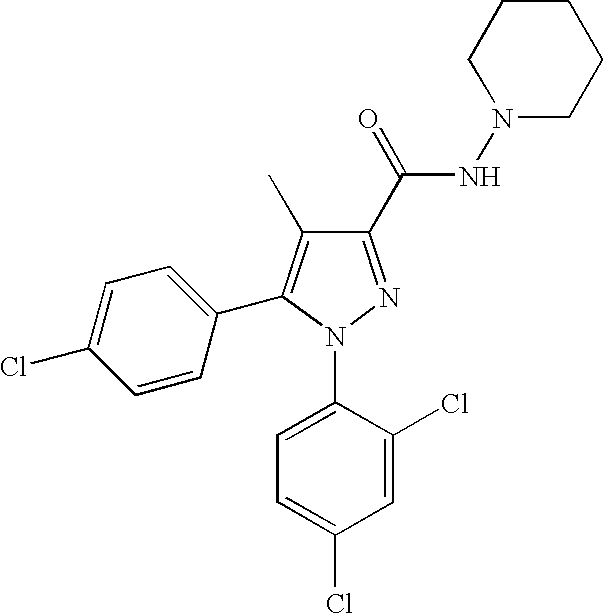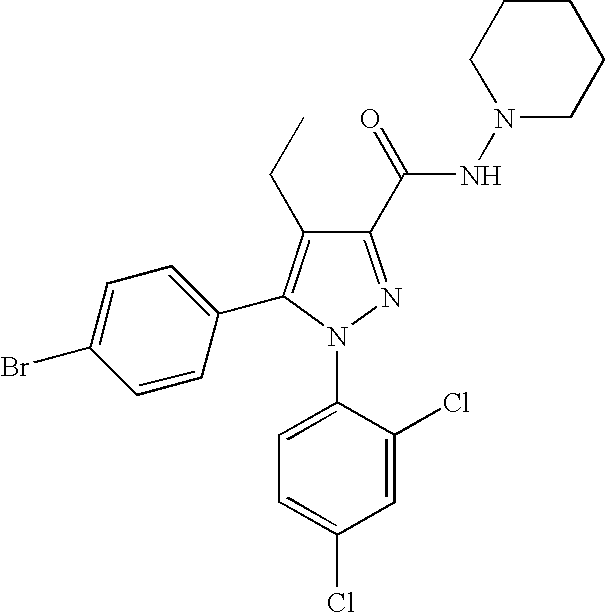Biphenyl-pyrazolecarboxamide compounds
a technology of pyrazole and compound, which is applied in the field of biphenylpyrazolecarboxamide compounds, can solve the problems of difficult formulation manufacturing, large number of dose-dependent discontinuations, and less well tolerated, and achieve the effects of reducing the van der waals radius, increasing the binding affinity of the receptor, and reducing the binding affinity
- Summary
- Abstract
- Description
- Claims
- Application Information
AI Technical Summary
Benefits of technology
Problems solved by technology
Method used
Image
Examples
example 1
[0247] 1-Benzyl-2,2,6,6-tetradeuteropiperidine. Dissolve 12.4 mmol of 1-benzylpiperidine-2,6-dione (e.g. see Tateoka Y et. al. Res. Commun. Chem. Pathol. Pharmacol. 1988 61: 315) in 20 mL of THF. Add this solution dropwise under argon to a cold (ice bath) suspension of 24.8 mmol of LiAlD4 in 50 mL of THF during 20 min. Remove ice bath, stir for 16 h at room temperature. Decompose excess LiAlD4 by careful dropwise addition of 0.47 mL water, 0.47 mL of 15% aq. NaOH, and 1.4 mL of water. Filter the resulting suspension through Celite® and concentrate in vacuo. Purify by silica gel column chromatography using concentrated NH4OH / methanol / methylene chloride eluant to yield the title compound.
[0248] Example 2: 2,2,6,6-Tetradeuteropiperidine. Dissolve 7.7 mmol of the product of Example 1 in 15 mL of methanol under argon. Add 140 mg of Pd(OH)2 / C (20% loading on carbon, wet with 50% water content). Stir under 20 psig of hydrogen for 6 h. Filter through Celite®, washing with additional methan...
example 13
[0259] Diethyl 3-thioxopentanedioate. Dissolve 14.1 mmol of diethyl 3-oxopentanedioate in 15 mL of toluene under argon add 49.4 mmol of sodium bicarbonate and 15.1 mmol of Lawesson's reagent. Stir for 1 h at room temperature then heat under reflux for 5 h. Cool, filter, and concentrate in vacuo. Purify the residue by silica gel chromatography using ethyl acetate / hexanes eluant to yield the title compound.
[0260] Example 14: Diethyl 3,3-difluoropentanedioate. To a solution of 4.7 mmol of the product of Example 13 in 2 mL of methylene chloride, add a catalytic amount (spatula tip) of SbCl3 and 6.6 mmol of bis(2-methoxyethyl)aminosulfur trifluoride. Stir for 6 h at room temperature, then dilute with about 15 mL of methylene chloride and pour onto 20 mL of saturated sodium bicarbonate. After gas evolution ceases, separate layers and extract the aqueous portion twice more with methylene chloride. Combine organic layers, wash with half-saturated brine, and dry over MgSO4. Concentrate in v...
example 64
[0311] CB1 and CB2 binding screens. Test compounds are assayed for concentration at which they displace WIN 55212-2 (5 μM) in cell lines expressing, respectively, recombinant human CB1 and CB2 receptors (see Rinaldi-Carmona M et al., J. Pharmacol. Exp. Ther. 1996 278: 871 and Munro S et al., Nature 1993 365: 61). Each compound tested displays sub-micromolar binding potency at the CB1 receptor and substantial selectivity for CB1 versus CB2.
PUM
| Property | Measurement | Unit |
|---|---|---|
| temperature | aaaaa | aaaaa |
| affinity | aaaaa | aaaaa |
| weight | aaaaa | aaaaa |
Abstract
Description
Claims
Application Information
 Login to View More
Login to View More - R&D
- Intellectual Property
- Life Sciences
- Materials
- Tech Scout
- Unparalleled Data Quality
- Higher Quality Content
- 60% Fewer Hallucinations
Browse by: Latest US Patents, China's latest patents, Technical Efficacy Thesaurus, Application Domain, Technology Topic, Popular Technical Reports.
© 2025 PatSnap. All rights reserved.Legal|Privacy policy|Modern Slavery Act Transparency Statement|Sitemap|About US| Contact US: help@patsnap.com



